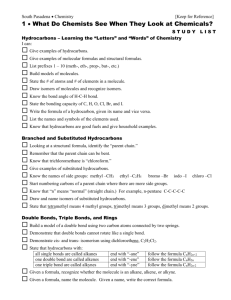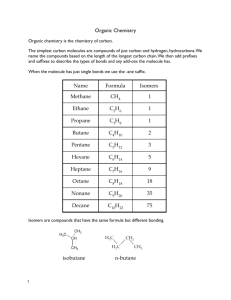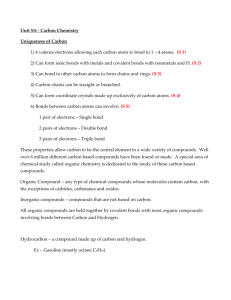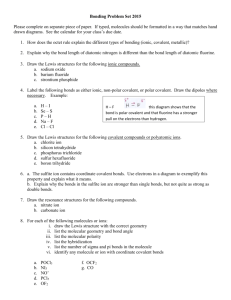Organic Chemistry HW PSI Chemistry
advertisement
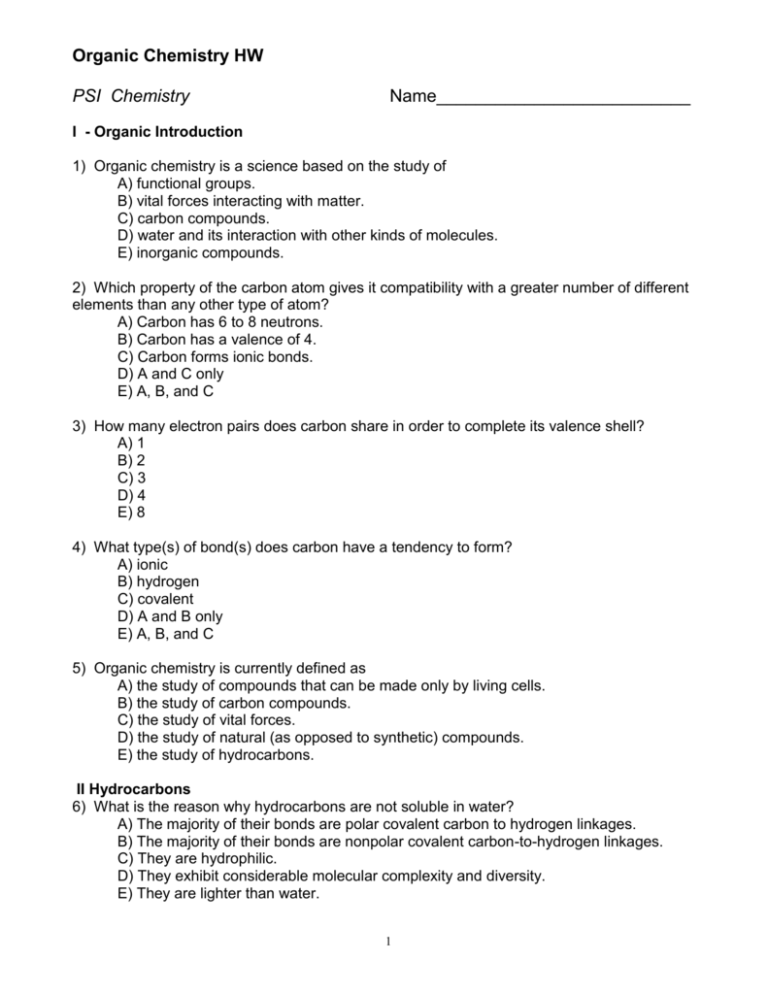
Organic Chemistry HW PSI Chemistry Name__________________________ I - Organic Introduction 1) Organic chemistry is a science based on the study of A) functional groups. B) vital forces interacting with matter. C) carbon compounds. D) water and its interaction with other kinds of molecules. E) inorganic compounds. 2) Which property of the carbon atom gives it compatibility with a greater number of different elements than any other type of atom? A) Carbon has 6 to 8 neutrons. B) Carbon has a valence of 4. C) Carbon forms ionic bonds. D) A and C only E) A, B, and C 3) How many electron pairs does carbon share in order to complete its valence shell? A) 1 B) 2 C) 3 D) 4 E) 8 4) What type(s) of bond(s) does carbon have a tendency to form? A) ionic B) hydrogen C) covalent D) A and B only E) A, B, and C 5) Organic chemistry is currently defined as A) the study of compounds that can be made only by living cells. B) the study of carbon compounds. C) the study of vital forces. D) the study of natural (as opposed to synthetic) compounds. E) the study of hydrocarbons. II Hydrocarbons 6) What is the reason why hydrocarbons are not soluble in water? A) The majority of their bonds are polar covalent carbon to hydrogen linkages. B) The majority of their bonds are nonpolar covalent carbon-to-hydrogen linkages. C) They are hydrophilic. D) They exhibit considerable molecular complexity and diversity. E) They are lighter than water. 1 7) Hydrocarbons A) are polar. B) are held together by ionic bonds. C) contain nitrogen. D) contain only hydrogen and carbon atoms. E) are held together by hydrogen bonds. 8) Which of the following hydrocarbons has a double bond in its carbon skeleton? A) C3H8 B) C2H6 C) CH4 D) C2H4 E) C2H2 9) The gasoline consumed by an automobile is a fossil fuel consisting mostly of A) aldehydes. B) amino acids. C) alcohols. D) hydrocarbons. E) thiols. 10) Hydrocarbons containing only single bonds between the carbon atoms are called __________. A) alkenes B) alkynes C) aromatics D) alkanes E) ketones 11) Hydrocarbons containing carbon-carbon triple bonds are called __________. A) alkanes B) aromatic hydrocarbons C) alkynes D) alkenes E) olefins 12) Alkynes always contain a __________. A) C=C bond B) C≡C bond C) C-C bond D) C-H bond E) C≡H bond 13) Alkenes always contain a __________. A) C=C bond B) C≡C bond C) C-C bond D) C=H bond E) C≡H bond 2 14) The molecular geometry of each carbon atom in an alkane is __________. A) octahedral B) square planar C) trigonal planar D) tetrahedral E) trigonal pyramidal 15) The general formula of an alkane is __________. A) C2nH2n+2 B) CnH2n C) CnH2n+2 D) CnH2n-2 E) CnHn 16) Alkenes have the general formula __________. A) CnH2n B) CnH2n-2 C) CnH2n+2 D) CnHn E) C2nHn 17) The compound below is an __________. A) alkyne B) alkene C) alkane D) aromatic compound E) olefin 18) Gasoline and water do not mix because gasoline is __________. A) less dense than water B) less viscous than water C) nonpolar and water is polar D) volatile and water is not E) polar and water is nonpolar 19) Which substance would be the most soluble in gasoline? A) water B) NaNO3 C) HCl D) hexane E) NaCl 20) __________ could be the formula of an alkene. A) C3H8 3 B) C3H6 C) C6H6 D) C17H36 E) CH8 III - Isomers 21) Structural isomers are molecules that A) are enantiomers. B) are hydrocarbons. C) have a ring structure. D) are mirror images. E) differ in the covalent arrangements of their atoms. 22) The two molecules shown above are best described as A) optical isomers. B) radioactive isotopes. C) structural isomers. D) nonradioactive isotopes. E) geometric isomers 23) Which one of the following compounds is an isomer of CH3CH2CH2 CH2 OH ? A) CH3CH2CH2 OH B) C) D) CH3OH The following questions are based on the 15 molecules illustrated in Figure below. Each molecule may be used once, more than once, or not at all. 4 24) Which of the following molecules are structural isomers? A) 1 and 4 B) 5 and 14 C) 6 and 12 D) 12 and 13 E) 14 and 15 25) Of the compounds below, __________ is an isomer of 5 A) B) C) D) E) IV – Functional Groups The following questions refer to the structures shown below. 6 26) Which of the structures contain(s) a carboxyl functional group? A) A B) B C) C D) C and E E) none of the structures 27) In which of the structures are the atoms bonded by ionic bonds? A) A B) B C) C D) C, D, and E only E) none of the structures 28) What is the name of the functional group shown in Figure? A) carbonyl B) ketone C) aldehyde D) carboxyl E) hydroxyl The following questions refer to the functional groups shown below. 29) Which is a hydroxyl functional group? 30) Which is an amino functional group? 31) Which is a carbonyl functional group? 32) Which is a carboxyl functional group? 33) Which is an acidic functional group that can dissociate and release H+ into a solution? 34) Which is a basic functional group that can accept H+ and become positively charged? The following questions refer to the molecules shown below. 7 35) Which molecule is water-soluble because it has a hydroxyl functional group? 36) Which molecule is an alcohol? 37) Alcohols are hydrocarbon derivatives in which one or more hydrogens have been replaced by a hydroxyl functional group. __________ is the general formula of an alcohol. A) R-CO-H B) R-CO-R C) R-CO-OH D) R-OH 38) Which one of the following is not an alcohol? A) acetone B) glycerol C) ethanol D) cholesterol E) ethylene glycol 39) Which of the following contains a peptide linkage? A) B) C) D) E) none of the above V- Macromolecules 40) Which of the following is not one of the four major groups of macromolecules found in living organisms? A) glucose B) carbohydrates C) lipids D) proteins E) nucleic acids 41) A molecule with the chemical formula C16H32O16 is probably a 8 A) carbohydrate. B) lipid. C) protein. D) nucleic acid. E) hydrocarbon. 42) What forces hold the strands of DNA together? A) covalent bonds B) hydrogen bonding C) ion-dipole attraction D) coordinate covalent bonds 43) Sugars are examples of what type of molecule? A) proteins B) carbohydrates C) nucleic acids D) amino acids E) salts 44) What is the molecule illustrated in Figure above? A) a saturated fatty acid B) an unsaturated fatty acid C) a polyunsaturated triacylglyceride D) a trans polyunsaturated triacylglyceride E) a steroid similar to cholesterol 45) The molecule shown above is a A) polysaccharide. B) polypeptide. C) saturated fatty acid. D) triacylglycerol. 9 E) unsaturated fatty acid. 46) Which of the following statements concerning unsaturated fats is true? A) They are more common in animals than in plants. B) They have double bonds in the carbon chains of their fatty acids. C) They generally solidify at room temperature. D) They contain more hydrogen than saturated fats having the same number of carbon atoms. E) They have fewer fatty acid molecules per fat molecule. 10 Answers I 1C 2B 3D 4C 5B II 6B 7D 8 D 9D 10 D 11 C 12 B 13 A 14 D 15 C 16 A 17 A 18 C 19 D 20 B III 21 E 22 C 23 D 24 A 25 A IV 26 E 27 E 28 D 29 A 30 D 31 B 32 C 33 C 34 D 35 A 36 A 37 D 38 A 39 A V 40 A 41 A 42 B 43 B 44 A 45 E 46 B 11


